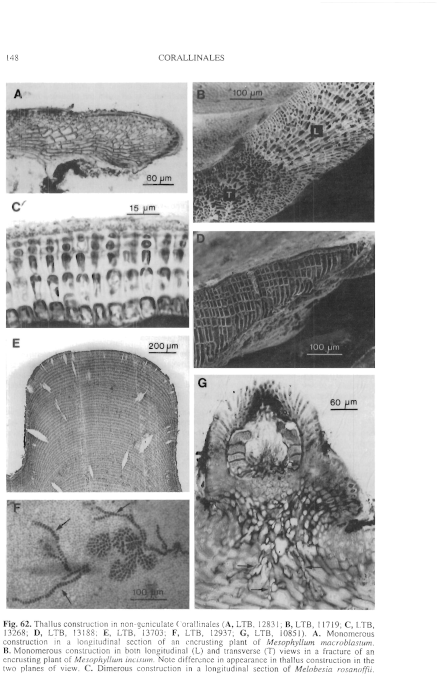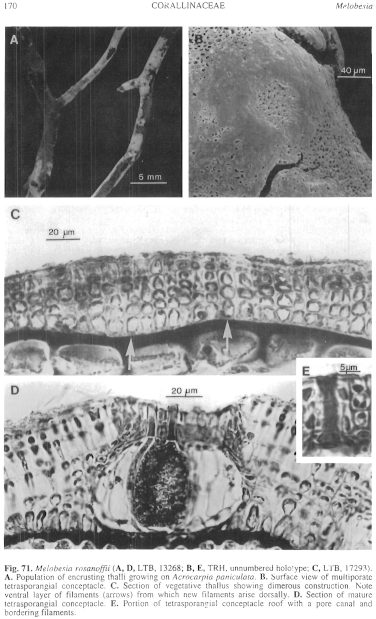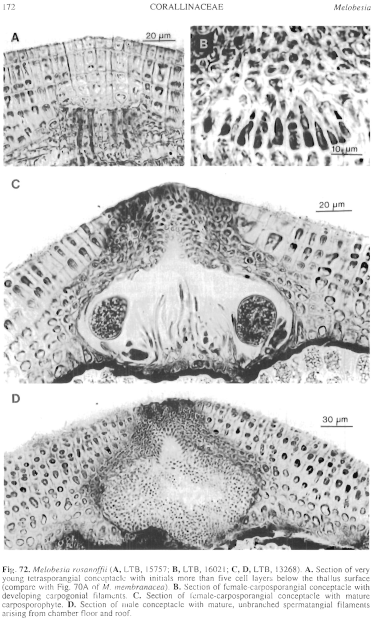|
|
|
|
|
|||||||||||
|
Electronic Flora of South Australia Species Fact Sheet
Phylum Rhodophyta – Class Florideophyceae – Order Corallinales – Family Corallinaceae – Subfamily Melobesioideae
Selected citations: Wilks & Woelkerling 1991: 525, figs 23–37.
Synonyms
Lithothamnion rosanoffii Foslie 1908: 5. Woelkerling 1993: 191.
Epilithon rosanoffii (Foslie) Foslie 1909: 55.
Thallus normally pinkish, encrusting, mostly 1–10 mm across and 25–113 vin thick; epigenous and completely affixed by cell adhesion. Structure pseudoparenchymatous with dorsiventral organisation throughout; construction dimerous, consisting (in longitudinal view) of a single ventral layer of branched, laterally cohering, filaments each composed of palisade or non-palisade cells 5–10 µm long and 5–20 high, and additionally of epithallial cells or multicellular simple or branched, laterally cohering, filaments that arise dorsally and more or less perpendicularly from most cells of ventral layer filaments and are each composed only of an epithallial cell 2–5 µm in diameter and 2–5 µm long or with additional subtending cells 2–15 µm in diameter and 2–15 µm long; distal walls of epithallial cells rounded or flattened but not flared; cell elongation characteristics uncertain; cells of adjacent filaments joined by cell-fusions; secondary pit-connections, haustoria, and trichocytes not observed.
Reproduction: Vegetative reproduction unknown. Gametangia and carposporophytes produced in uniporate conceptacles; tetrasporangia produced in multiporate conceptacles. Bisporangia unknown.
Gametangial thalli monoecious or dioecious; carpogonia and spermatangia produced in separate conceptacles. Carpogonia terminating 2-celled filaments arising from the female conceptacle chamber floor. Mature female-carposporangial conceptacle roofs more or less flush with surrounding thallus surface, 35–63 µm thick, composed of 5–14 layers of cells and commonly including at least one layer of longer cells overlying layers of small, densely packed cells; conceptacle chambers 100–193 µm in diameter and 30–55 high. Carposporophytes when mature apparently lacking an evident fusion cell and consisting of several-celled gonimoblast filaments bearing terminal carposporangia 25–30 µm in diameter. Spermatangial filaments unbranched, arising from the floor, walls and roof of male conceptacle chambers, mature male conceptacle roofs more or less flush with surrounding thallus surface, 25–43 µm thick, composed of 5–10 layers of cells including several layers of longer cells overlying layers of small, densely packed cells; conceptacle chambers 100–138 µm in diameter and 30–75 µm high.
Tetrasporangial conceptacle roofs more or less flush with or slightly sunken below surrounding surface, not normally differentiated into a peripheral rim and a central sunken pore-plate but pore-plate sharply differentiated anatomically from the remainder of roof and composed of cells that differ in size and shape from other roof cells, roof 2–7 cells thick above the chamber; conceptacle chambers 45–118 µm in diameter and 40–80 µm high; tetrasporangial initials situated five or more cell layers below the thallus surface, scattered across the conceptacle chamber floor, each mature sporangium 10–25 µm in diameter and 25–63 µm long, containing zonately arranged tetraspores and possessing an apical plug that blocks a roof pore prior to spore release.
Type from Port Phillip Bay, Vic.; holotype in TRH (unnumbered; includes slides 1342, 1641, and one unnumbered slide); depicted in Wilks & Woelkerling (1991, figs 23, 24), additional data provided by Woelkerling (1993, p. 191).
Distribution: Three Mile Rocks, Beachport, S. Aust., to Rye, Vic., and from Clydes I., Eaglehawk Neck, Tas.
Taxonomic notes: Additional records are provided by Wilks & Woelkerling (1991).
Melobesia rosanoffii has been found epiphytically on the brown algae Acrocarpia and Cystophora and on the red alga Laurencia in intertidal pools and subtidally to depths of 6 m. Most collections contain large populations of thalli and include both gametangial and tetrasporangial individuals.
References:
FOSLIE, M. (1908). Algologiske notiser. V. K. norske Vidensk. Selsk. Skr. 1908(7), 1–20.
FOSLIE, M. (1909). Algologiske notiser. VI. K. norske Vidensk. Selsk. Skr. 1909(2), 1–63.
LEMOINE, M.(Mme P.) (1912). Catalogue des mélobésiées de l'Herbier Thuret (Muséum National d'Histoire Naturelle à Paris). Bull. Soc. bot. Fr. 58, LI-LXV. Effective publication date: Jan. 1912 (stated on cover of offprint); offprint issued without change in pagination
WILKS, K.M. & WOELKERLING, W.J. (1991). Southern Australian species of Melobesia (Corallinaceae, Rhodophyta). Phycologia 30, 507–533.
WOELKERLING, Wm.J. (1993). Type collections of Corallinales (Rhodophyta) in the Foslie Herbarium (TRH). Gunneria 67, 1–289.
The Marine Benthic Flora of Southern Australia Part IIIB complete list of references.
Publication:
Womersley, H.B.S. (28 June, 1996)
The Marine Benthic Flora of Southern Australia
Rhodophyta. Part IIIB. Gracilarialse, Rhodymeniales, Corallinales and Bonnemaisoniales
Reproduced with permission from The Marine Benthic Flora of Southern Australia Part IIIB 1996, by H.B.S. Womersley. Australian Biological Resources Study, Canberra. Copyright Commonwealth of Australia.
Illustrations in Womersley Part IIIA, 1996: FIGS 62C, 71, 72.

Figure 62 enlarge
Fig. 62. Thallus construction in non-geniculate Corallinales (A, LTB, 12831; B, LTB, 11719; C, LTB, 13268; D, LTB, 13188; E, LTB, 13703; F, LTB, 12937; G, LTB, 10851). A. Monomerous construction in a longitudinal section of an encrusting plant of Mesophyllum macroblastum. B. Monomerous construction in both longitudinal (L) and transverse (T) views in a fracture of an encrusting plant of Mesophyllum incisum. Note difference in appearance in thallus construction in the two planes of view. C. Dimerous construction in a longitudinal section of Melobesia rosanoffii.

Figure 71 enlarge
Fig. 71. Melobesia rosanoffii (A, D, LTB, 13268; B, E, TRH, unnumbered holotype; C, LTB, 17293). A. Population of encrusting thalli growing on Acrocarpia paniculata. B. Surface view of multiporate tetrasporangial conceptacle. C. Section of vegetative thallus showing dimerous construction. Note ventral layer of filaments (arrows) from which new filaments arise dorsally. D. Section of mature tetrasporangial conceptacle. E. Portion of tetrasporangial conceptacle roof with a pore canal and bordering filaments.

Figure 72 enlarge
Fig. 72. Melobesia rosanoffii (A, LTB, 15757; B, LTB, 16021; C, D, LTB, 13268). A. Section of very young tetrasporangial conceptacle with initials more than five cell layers below the thallus surface (compare with Fig. 70A of M. membranacea). B. Section of female-carposporangial conceptacle with developing carpogonial filaments. C. Section of female-carposporangial conceptacle with mature carposporophyte. D. Section of male conceptacle with mature, unbranched spermatangial filaments arising from chamber floor and roof.

|
Email Contact: State Herbarium of South Australia |

|